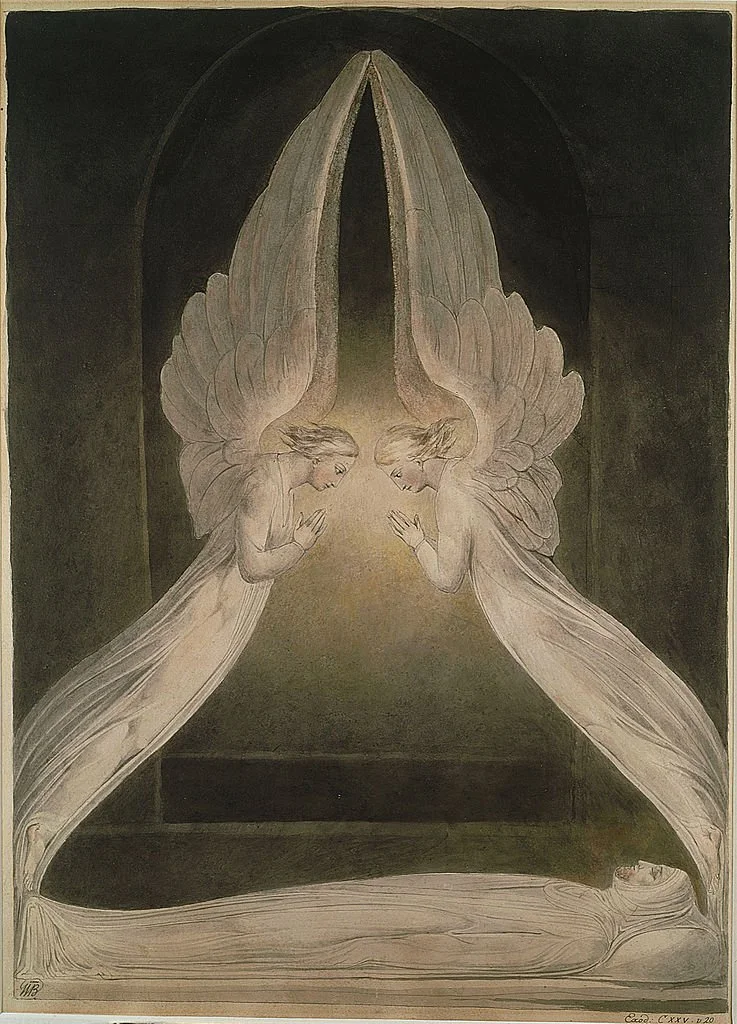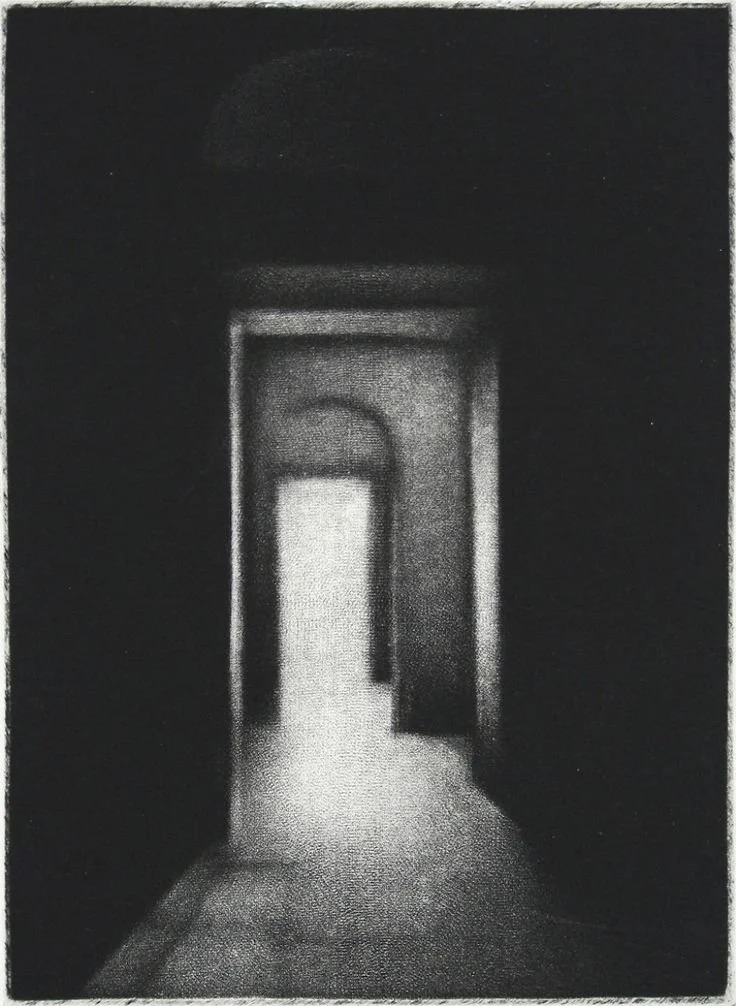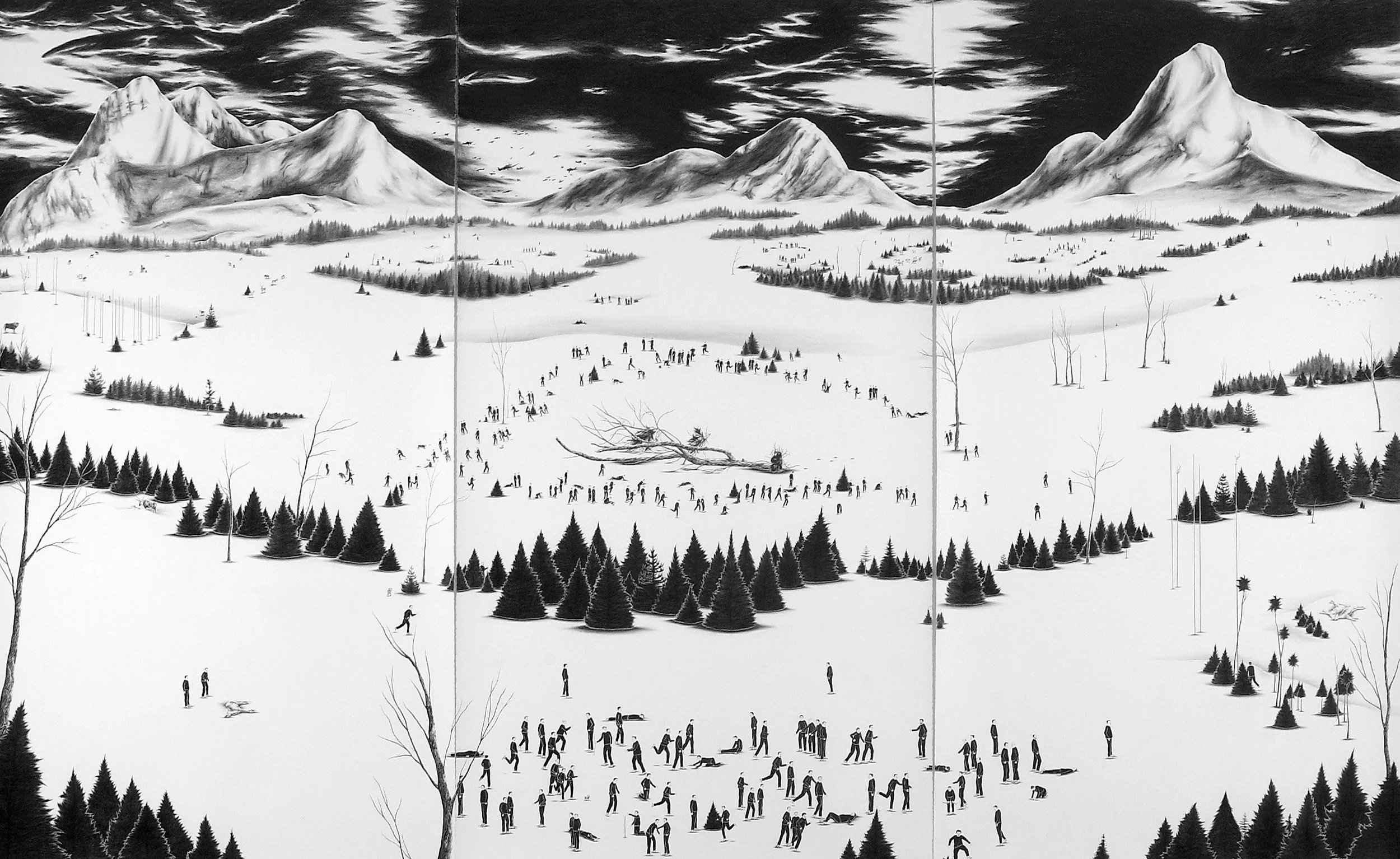▷Three Keys to my research
Symbols and Metaphors
Reference artists and books
William Blake (Symbolism)
Odilon Redon (Symbolism)
Cleo Wilkinson (Printmaker)
The Spiritual Diary by Emanuel Swedenborg
Heaven and Hell by Emanuel Swedenborg
The lightness of being: Mass, Ether, and the Unification of Forces
by Frank Wilczek
Story Telling
Reference artists
Robyn O’Neil (Contemporary narrative art)
Hedi Kyle’s artist books
Cultural Identity
Reference book
Chasing Rumi by Roger Housden
The Love Poems of Rumi
▷Studying Peter Bruegel Elder’s prints.
I started studying one of a series of twelve prints, Penitent Mary Magdalene. Some elements are an ever-present reminder of the script - for instance, the Magdalene in the fore corner on the right. The landscape again unfolds a panorama with mountains, valley stream, town, castle, and the like.
For my work, I picked an element at the top right from this and copied it. The Mother of Jesus hovers in a radiance. I found it was illustrated with short and weak strokes while reproducing the print. It evokes a quiet presence while naturally blending in. It emphasises that spiritual existence is uncertain yet strongly reflects on our minds.
PENITENT MARY MAGDALENE, Engraving, Peter Bruegel The Elder
Small Landscape, lithography with zinc plate, 21 x 29.7 cm
▷Symbolism
Next, I studied Symbolism art, including Odilon Redon and William Blake. It is because of many interesting Spiritual Arts involved in the symbolist movement. The Symbolist movement's different painters and genres are linked by their emphasis on feelings, sentiments, conceptions, and personality rather than actuality. In addition, they often used much light when depicting Heaven and Hell in the Bible. And light was sometimes used as a symbol to express spirituality and mysticism.
The Angels hovering over the body of Christ in the Sepulchre, William Blake
The Book of Light, Odilon Redon
▷What is “light” in the spiritual world?
The question came to mind as to why light is treated as an essential motif. Emanuel Swedenborg's spiritual journey has influenced many artists who tell their spirituality, including William Blake. I started reading his books, thinking they were the key to deepening my knowledge of light. Then I found that they use the word “light" and “heat" when they mention the angel, love and any other substances in heaven.
I also studied light from the other perspective. The book, The lightness of being: Mass, Ether, and the Unification of Forces, by Frank Wilczek, explains the existence of light through elementary particle physics, which was a new way of looking at the light for me. To summarise the book, it said that matter itself is a particle of light and that our perception of matter as a separator from light is wrong. The story made me rethink the light and humans. What are substances we treat? By seeing things from this perspective, my view of thoughts broadened.
▷Looking for the technique for drawing lights
I mainly focused on the light and drew out the light differently in each work - for instance, simple lines, a jagged line and creating shadows. Cleo Wilkinson, uses the mezzotint technique. It is interesting to show the light that looks like it is coming from the darkness. I found that intentionally creating lights (or shadows) is possible for my further images. In the etching process, there are other techniques for making tones in Aquatint so I will look at more of the etching afterwards.
Murmurs, Cleo Wilkinson
Penultimate, Cleo Wilkinson
▷The fable Chasing Rumi
After reading the book, Chasing Rumi written by Roger Housden, I am fond of this book because the story tells ambiguous spirituality between encounters with different backgrounds over the country and religions during many conversations. It also makes me consider my current situation, which is changing from coming to other countries and cultures.
Moreover, the story presents many existing cities, sacred places, paintings, and poems. I am interested in one of those places, Meteora in Greece. Meteora consists of high rocks and Eastern Orthodox monasteries on the top. This place is so mystical. The reason is that the rocks, which rise for kilometres, evoke the long months before civilisation. There might be a sleeping history we still do not know inside the rocks.
▷Making a narrative image
Robyn O'Neil is a narrative artist. In this drawing below, she made her version of The Garden of Earthly Delights by Hieronymus Bosch, utilising Robyn's familiar things. A copy of Bosch's work composition in her work founds me in the way of storytelling. She often uses her father in her drawings, but as she said, he became the archetype for Humanity. Those people were no longer her father or a friend, illustrating death, fear, love and hate.
Everything that stands will be at odds with its neighbor, and everything that falls will perish without grace. Robyn O’Neil
I ended up making my image in the opposite way. First, I chose to use the book-binding form to tell a story. Then I mixed elements from William Blake’s painting and the existing place(Meteora) in my composition with the boustrophedon structure. This mystic place invites the imagination of the connection between the present and the past, and I believe this book structure fits this long vertical image. I focused on emphasising the layer of the high rock and the impression of the light using the chine colle technique with gold and silver tissue papers.
▷Thinking through the Artist book (About the project of this later)
I expanded my idea in the bookmaking workshop. I could combine the different forms of books with the stories. Hedi Kyle's book-holding methods are inspiring. Her holding structures are not only the way of the book but also the sculpture. I have started a new book project by experimenting with her blizzard(crown) binding. The prints are allowed to insert in and out of the binding, which means I can also change the page order. I am also trying to find a wide dimension for my book. The photo below is lithography on the zinc plate on the current work. This will might be part of a vast book. At the same time, a small-size etching series is going on. This series will be based on poems from The Love Poem of Rumi and look at existing places worldwide. This might be connected to the previous book because of the concept of using the history of the land. The concept always considers time and reminds us of our past beliefs.
Bibliography
Swedenborg, E. (1998) The spiritual diary. Translated by K. Takahashi. Kadokawa.
Swedenborg, E. and Dole, G.F. (2020) Heaven and hell. West Chester, PA: Swedenborg Foundation.
Housden, R. (2002) Chasing Rumi: A fable about finding the heart's desire. San Francisco: HarperSanFrancisco.
Wilczek, F. (2010) The lightness of being: Mass, ether, and the unification of forces. Translated by M. Yoshida. Tokyo: Hayakawa.
Kyle, H. and Warchol, U. (2018) Art of the Fold: How to Make Innovative Books and Paper Structures. Laurence King Publishing.
Rūmī Aḥmad, Chopra, D. and Kia, F. (1993) The love poems of Rumi. London: Rider.
Karin Orchard, ‘Kurt Schwitters: Reconstructions of the Merzbau’, in Tate Papers no.8, https://www.tate.org.uk/research/tate-papers/08/kurt-schwitters-reconstructions-of-the-merzbau, accessed 31 December 2022.

















